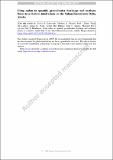| dc.contributor.author | Dabrowski, Jessica S | |
| dc.contributor.author | Charette, Matthew A | |
| dc.contributor.author | Mann, Paul J | |
| dc.contributor.author | Ludwig, Sarah M | |
| dc.contributor.author | Natali, Susan M | |
| dc.contributor.author | Holmes, Robert M | |
| dc.contributor.author | Schade, John D | |
| dc.contributor.author | Powell, Margaret | |
| dc.contributor.author | Henderson, Paul B | |
| dc.date.accessioned | 2021-09-20T17:16:53Z | |
| dc.date.available | 2021-09-20T17:16:53Z | |
| dc.date.issued | 2020-02-13 | |
| dc.identifier.uri | https://hdl.handle.net/1721.1/131394 | |
| dc.description.abstract | Abstract
Northern lakes are a source of greenhouse gases to the atmosphere and contribute substantially to the global carbon budget. However, the sources of methane (CH4) to northern lakes are poorly constrained limiting our ability to the assess impacts of future Arctic change. Here we present measurements of the natural groundwater tracer, radon, and CH4 in a shallow lake on the Yukon-Kuskokwim Delta, AK and quantify groundwater discharge rates and fluxes of groundwater-derived CH4. We found that groundwater was significantly enriched (2000%) in radon and CH4 relative to lake water. Using a mass balance approach, we calculated average groundwater fluxes of 1.2 ± 0.6 and 4.3 ± 2.0 cm day−1, respectively as conservative and upper limit estimates. Groundwater CH4 fluxes were 7—24 mmol m−2 day−1 and significantly exceeded diffusive air–water CH4 fluxes (1.3–2.3 mmol m−2 day−1) from the lake to the atmosphere, suggesting that groundwater is an important source of CH4 to Arctic lakes and may drive observed CH4 emissions. Isotopic signatures of CH4 were depleted in groundwaters, consistent with microbial production. Higher methane concentrations in groundwater compared to other high latitude lakes were likely the source of the comparatively higher CH4 diffusive fluxes, as compared to those reported previously in high latitude lakes. These findings indicate that deltaic lakes across warmer permafrost regions may act as important hotspots for CH4 release across Arctic landscapes. | en_US |
| dc.publisher | Springer International Publishing | en_US |
| dc.relation.isversionof | https://doi.org/10.1007/s10533-020-00647-w | en_US |
| dc.rights | Article is made available in accordance with the publisher's policy and may be subject to US copyright law. Please refer to the publisher's site for terms of use. | en_US |
| dc.source | Springer International Publishing | en_US |
| dc.title | Using radon to quantify groundwater discharge and methane fluxes to a shallow, tundra lake on the Yukon-Kuskokwim Delta, Alaska | en_US |
| dc.type | Article | en_US |
| dc.contributor.department | Massachusetts Institute of Technology. Department of Earth, Atmospheric, and Planetary Sciences | |
| dc.contributor.department | Woods Hole Oceanographic Institution | |
| dc.eprint.version | Author's final manuscript | en_US |
| dc.type.uri | http://purl.org/eprint/type/JournalArticle | en_US |
| eprint.status | http://purl.org/eprint/status/PeerReviewed | en_US |
| dc.date.updated | 2020-09-24T21:12:41Z | |
| dc.language.rfc3066 | en | |
| dc.rights.holder | Springer Nature Switzerland AG | |
| dspace.embargo.terms | Y | |
| dspace.date.submission | 2020-09-24T21:12:41Z | |
| mit.license | PUBLISHER_POLICY | |
| mit.metadata.status | Authority Work and Publication Information Needed | |
